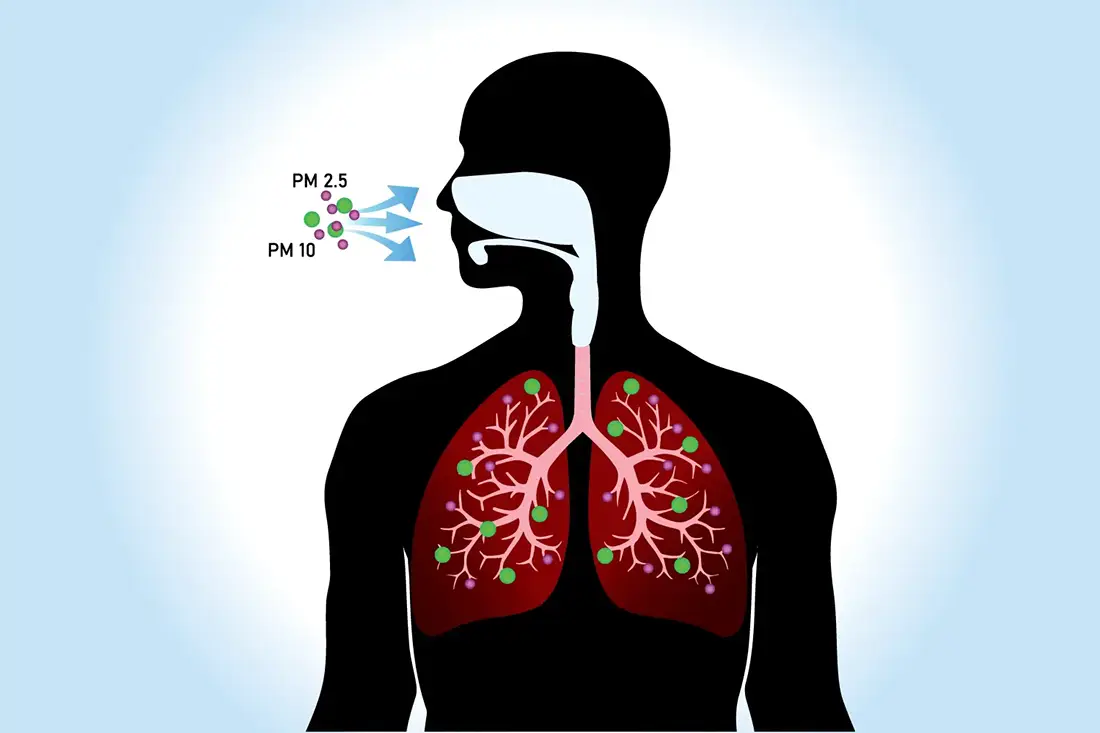Air Pollutants
In this post-pandemic world, optimal indoor air quality has become a central priority — not just for comfort, but for health, productivity, and long-term sustainability. This renewed focus has led to a growing demand for well-ventilated indoor environments, with ventilation strategies that are also monitored, energy-efficient, and low-emission. These systems aim to strike a critical balance: maximising air quality while minimising the environmental impact.
Carbon Dioxide (CO2)
What is CO2?

Carbon dioxide (CO2) is a colourless and odourless gas that is
naturally
present
in our
atmosphere. It plays an important role in life on Earth: humans and animals
exhale
it when
they breathe, while plants use CO2 to grow through photosynthesis. It
is
also
released when
fossil fuels — such as oil, gas, and coal — are burned.
CO2 is one of the main greenhouse gases, trapping heat in the
atmosphere.
Without
these
gases, the Earth would be too cold to support life. However, human activities
have
dramatically increased the amount of CO2, disturbing the natural
balance
and
leading to
global warming and climate change.
What are the effects of CO2?
In outdoor air, the CO2 level is typically around 400 ppm (parts per million), which is considered normal and harmless to humans and animals. In indoor spaces — such as homes, schools, or offices — CO2 concentrations are the result of a combination of outdoor CO2, indoor breathing and the ventilation of the building. Indoor CO2 levels between 400—1000 ppm are acceptable. When the values exceed this range, additional measures should be taken.
Moderate to high levels of carbon dioxide can cause headaches, reduced concentration and fatigue while higher concentrations can even produce drowsiness, dizziness and vomiting. Loss of consciousness can occur at extremely high concentrations. To prevent or reduce high concentrations of carbon dioxide in a building or room, fresh air should be supplied to the room.
CO2 sensors: nondispersive infrared (NDIR) and photoacoustic spectroscopy (PAS) sensors
As buildings become more energy-efficient and thus airtight, less fresh air is coming in. In addition, indoor CO2 levels constantly change depending on the ventilation rate, the amount of people and the length of time they are present in an enclosed space. Therefore, ventilation is essential to keep indoor CO2 levels low. To ensure proper ventilation, it is recommended to install CO2 sensors - which indicate when fresh air needs to be supplied - and to regularly check and replace the filters of indoor fan systems.
Nondispersive Infrared (NDIR) and Photoacoustic Spectroscopy (PAS) CO2 sensors are two types of CO2 sensors based on the gas absorption principle. Different gases absorb light at specific wavelengths. The light is tuned and emitted at a certain wavelength, the receiver measures the rate of absorption — and subsequently — the concentration of the gas can be calculated. To measure CO2, the light is tuned at a wavelength close to 4.26 μm which corresponds to the absorption of CO2.
Nondispersive infrared (NDIR) sensors use an infrared light emitter, typically a LED, which sends light into a chamber filled with ambient air to a receiver measuring the incoming light level. The advantage of NDIR sensors is their lifespan, minimal interference of other gases, low life-cycle cost and precise and stable long-term operation.
One of the disadvantages of NDIR sensors is their size. A certain minimum distance between the light emitter and receiver is needed to achieve a certain level of accuracy. This limits the use of NDIR sensor in certain applications.
The Sentera CO2 duct and outdoor sensors are based on this principle.

Photoacoustic spectroscopy (PAS) sensors use the same working principle of the absorption wavelengths but unlike the NDIR sensors that measure the receiving light from an emitting LED, PAS sensors measure the absorption with a microphone.
As the light passes through the gas, CO2 molecules absorb specific wavelengths which leads to a localised heating effect. The heated CO2 molecules then expand, causing pressure fluctuations in the surrounding air, and generating an acoustic wave (sound). A microphone captures these sound waves. The amplitude of the acoustic signal is directly related to the concentration of CO2 in the sample.
Advantages of PAS sensors are their high sensitivity, rapid response time, wide dynamic range and minimal interference of other gases. Another major advantage of PAS sensors is the possibility to create a compact and portable design.
PAS sensors represent a powerful tool for monitoring CO2 levels across various applications. They are ideal for environmental monitoring, indoor air quality assessment, greenhouse management, and industrial applications.
The Sentera CO2 room sensors all use this type of sensing technology.

All our sensors use the Automatic Baseline Correction (ABC) self-calibration algorithm. This algorithm is designed to be used in applications where CO2 concentrations will drop to outside ambient conditions of ±400 ppm at least once in a 7-day period for 15 minutes or longer. This situation typically occurs when the room is unoccupied and this low level is considered fresh outside air (the baseline). With this principle you don’t have to recalibrate the sensor after installation or in the course of time.
Volatile Organic Compounds (VOCs)
What are VOCs?
Volatile Organic Compounds (VOCs) are a large group of chemicals commonly found in many everyday products, such as home furnishings, cleaning products, office supplies and building materials. These substances easily evaporate at room temperature, releasing gases into the air. The concentration of VOCs is usually 2 to 5 times higher indoors than outdoors.

Common examples of VOCs include benzene, toluene, xylene, formaldehyde, methylene chloride, and ethylene glycol. Typical sources are paints and varnishes, carpets, adhesives, cleaning products and disinfectants, air fresheners, smoking, photocopiers, building materials like foam, hair sprays, perfumes, and burning wood. VOCs are also emitted by humans and animals through breath, sweat, and directly from the skin.
What are the effects of VOCs?
VOCs affect both human health and the environment. The risk of health problems depends on the specific chemical, its concentration, and the duration of exposure.
Because VOCs come from various sources, the origin varies depending on the room. For example:
- Kitchen and bathroom: cooking, cleaning products
- Living room, bedroom, and office: building materials, furniture, carpets, cleaning products, and human (and animal) presence
- Garage and storage room: exhaust fumes, automotive fluids, paints and pesticides
VOC-related health risks also depend on the exposure levels and duration.
- Long-term exposure to low levels of VOCs may increase health risks, especially for people with asthma or those sensitive to chemicals. Because VOCs include many different compounds, each has its own level of toxicity and health effects.
- Short-term exposure to high levels can cause headaches, irritation of the eyes, nose, and throat, allergic reactions, reduced concentration, dizziness, and nausea.
- Long-term exposure to high levels may damage the liver, kidneys, and central nervous system; some VOCs (like benzene and formaldehyde) are known carcinogens.
VOCs also contribute to ground-level ozone formation, which leads to smog, and they harm ecosystems by reducing air quality and adding to atmospheric pollution.
To protect health, it is best to limit exposure to products and materials containing VOCs. The best way to reduce VOC levels is simply to avoid them. However, during activities like remodelling or renovation, avoiding VOCs is often impossible. In such cases, only buy and keep the necessary amounts of paints, detergents, and adhesives. If storage is needed, store chemicals in areas where people do not spend much time, minimising exposure in case of leaks.
VOC sensors: measuring total volatile organic compound (TVOC) concentration
Increase the circulation of fresh air by opening windows and doors or using fans to bring in outdoor air. Keep temperature and humidity levels low, as VOCs tend to off-gas more at higher temperatures and humidity.
To ensure indoor air quality is safe, you can use a sensor. The Sentera TVOC sensors measure the total VOC (TVOC) concentration, along with temperature and relative humidity, and have high selectivity to hydrogen (H2).
In indoor environments, hydrogen levels tend to correlate with carbon dioxide
(CO2)
levels
because human breath contains significant amounts of both CO2 (about 4%) and
H2 (around 10
ppm). This correlation helps distinguish human presence from other contaminants, allowing
ventilation systems to be controlled based on occupancy.
Our sensors alert you via LED, SMS or e-mail when VOC levels reach an alarming point,
indicating that ventilation should be increased to remove contaminated air. Typical
applications include fitness rooms, waiting areas, nightclubs, restaurants, and production
halls involving paints and chemicals.
Controlling ventilation according to TVOC levels is especially useful in environments where indoor air quality needs to be continuously optimised, such as living rooms, office buildings, and certain industrial settings.
Over 3 million deaths per year can be attributed to household air pollution
Combustion Pollutants
What are combustion pollutants?
Combustion is a major source of air pollution, both indoors and outdoors, particularly through the burning of fossil fuels and biomass for energy.

In indoor environments,
pollution arises from unvented cooking and heating stoves, boilers, tobacco
smoke,
and the
burning of materials like coal, wood, dung, candles, incense, and kerosene.
These
activities
release harmful combustion pollutants—such as carbon monoxide (CO), nitrogen
dioxide
(NO2),
sulfur dioxide (SO2), and particulate matter (PM)—which pose
significant
health
risks,
especially when ventilation is poor.
Exposure to these pollutants in poorly ventilated indoor spaces poses
significant
health
risks, making proper ventilation and cleaner fuel use important for indoor air
quality and
health.
Carbon monoxide (CO)
Carbon monoxide (CO) is a colourless, odourless and tasteless gas that is formed by the
incomplete combustion of carbon-containing fuels, such as wood or coal, or via poorly
maintained heating systems.
CO can also enter the building from attached garages where cars are running or from outdoor
sources, such as nearby highways or industrial facilities. It can accumulate indoors, posing
a risk to occupants.
CO is a highly toxic gas as it binds to hemoglobin in the blood and prevents oxygen transport. Symptoms of CO poisoning include headache, dizziness, weakness, nausea, and confusion, which can progress to unconsciousness or death.
Nitrogen dioxide (NO2)
Nitrogen Dioxide (NO2) is a reddish-brown gas that is formed by high-temperature combustion where nitrogen (from the air) reacts with oxygen to form nitrogen oxides (NO and NO2). Major sources of NO2 include gas stoves, kerosene and water heaters, power plants, exhaust of cars, trucks and buses; shipping and the industrial combustion of fossil fuels. Exposure to high levels of NO2 can cause irritation of the lungs and airways, increasing the risk of respiratory infections and aggravating asthma.
Sulfur dioxide (SO2)
Sulfur dioxide (SO2) is a pungent, choking gas that is formed by the burning of sulfur-containing fuels, such as coal, diesel, and petroleum oil and industrial processes such as the melting of metals.
SO2 is a major health concern, causing a range of harmful effects on the lungs, including wheezing, shortness of breath, and chest tightness.
Particulate matter (PM2.5 and PM10)
Particulate matter (PM) refers to a complex mixture of tiny solid particles and liquid droplets suspended in the air. These particles vary in size, shape, and chemical composition, and are classified primarily by their diameter.

The two most commonly monitored sizes are PM10 (particles with a diameter of 10 µm or less) and PM2.5 (particles with a diameter of 2.5 µm or less). Because of their small size, PM10 and especially PM2.5 can be inhaled deeply into the lungs. PM2.5 particles are particularly dangerous because they can penetrate the lungs’ alveoli and even enter the bloodstream, increasing the risk of serious health problems such as respiratory diseases, cardiovascular disease, and premature death.
Indoor sources of PM include combustion activities such as tobacco smoking, cooking with gas or wood-burning stoves, burning candles, and emissions from heating appliances. Additionally, outdoor particles from traffic and other sources can infiltrate indoor spaces, contributing to indoor PM levels.
Research shows that particulate matter contributes to over 90% of the health impacts linked to indoor air pollution! Controlling indoor PM exposure is therefore crucial. Strategies include venting fuel-fired combustion appliances outdoors, using exhaust fans when cooking, and avoiding unvented stoves, fireplaces, or heaters indoors. Proper ventilation and the use of cleaner energy sources can significantly reduce indoor PM concentrations.
Smoke
Secondhand smoke or environmental tobacco smoke, is a mixture of smoke exhaled by smokers and the smoke released from burning tobacco products such as cigarettes, cigars, and pipes.
Secondhand smoke is a known carcinogen and poses serious health risks with no safe level of
exposure.
It can accumulate indoors — especially in homes and cars — leading to
numerous
health
problems in both adults and children, including cardiovascular disease, lung cancer, sudden
infant death syndrome (SIDS), and frequent, severe asthma attacks. The only effective way to
eliminate secondhand smoke indoors is to prohibit smoking entirely, as ventilation and
filtration methods can reduce but not remove this pollutant.
Wood smoke is another significant indoor air pollutant, produced by the burning of wood in residential settings such as wood stoves, fireplaces, and outdoor fire pits. Wood smoke contains harmful pollutants including fine particulate matter, carbon monoxide, and volatile organic compounds, all of which can negatively affect indoor air quality. Exposure to these pollutants is particularly dangerous for vulnerable groups such as children, older adults, and individuals with heart or lung conditions.
Biological Pollutants
What are biological pollutants?
Biological pollutants are living organisms or their by-products, including bacteria, viruses,
fungi, mould, dust mites, pet dander, and pollen, which can negatively affect human health.
These contaminants can cause various health issues ranging from allergic reactions, asthma,
infectious diseases, and more severe toxic reactions.
Biological pollutants are commonly found in damp areas like bathrooms, kitchens, and
basements, as well as poorly ventilated spaces such as attics and crawl spaces, and can be
introduced through pets, plants, carpets and outdoor air. Good housekeeping, and maintenance
of heating and air conditioning equipment, are very important. Adequate ventilation and good
air distribution also help. The key to mould control is moisture control. Employ integrated
pest management to control insect and animal allergens.
Bacteria
Bacteria are a diverse group of single-celled organisms. Some are completely harmless, while others cause severe illnesses including pneumonia, urinary tract infections, and foodborne illnesses. Bacteria live on human beings, animals, in soil, and even on plant debris. Most are no threat, but airborne disease-causing bacteria pose a risk, especially for those with weakened immune systems. However, the impact depends entirely on the type of bacteria.
Viruses
Viruses are microscopic organisms that can only reproduce by infecting a host cell. They can cause a wide range of illnesses, from the common cold to more serious conditions. Viruses are primarily spread person-to-person but can also survive on surfaces and become airborne (e.g., colds and flu). When an infected person coughs or sneezes, tiny droplets containing the virus are released. In enclosed spaces, these droplets can hang in the air, increasing the risk of transmission.
Fungi (mould and mildew)
Fungi are organisms that form visible colonies on damp surfaces. Moulds and mildew release spores into the air that cause allergies and respiratory irritation. Some toxin-producing species can contribute to serious health issues, including cancer. Fungi mainly appear on damp materials, due to leaks, water damage, or high humidity, and in water-prone areas of the home like kitchens and bathrooms.
Dust mites
Dust mites are microscopic arachnids that are commonly found in soft furnishings like bedding, carpets, and furniture. While the mites themselves are not harmful, their droppings and decomposing bodies contain powerful allergens that can trigger asthma attacks and allergic reactions.
Pet dander

Pet dander consists of small skin flakes that animals naturally shed. It contains
proteins
that act as potent allergens.
Pet dander is lightweight and easily becomes airborne, circulating throughout
the
home.
It causes reactions like sneezing, congestion, and also worsens asthma.
It lingers for extended periods even after the dog, cat, bird, or other furry or
feathered
friends have left the house.
Pollen
Pollen are microscopic grains released by trees, grasses, and weeds during the flowering season for reproduction and are a major seasonal allergen. Pollen enter homes through open windows and doors. It triggers hay fever symptoms such as runny nose, sneezing, itchy eyes in many individuals, significantly impacting those with allergies. Even small amounts of pollen worsen allergy symptoms for sensitive individuals.
Practical strategies to reduce exposure
Reducing exposure to biological air pollutants in your home involves a combination of
strategies focused on controlling humidity, improving ventilation, and maintaining
cleanliness.
Keep indoor relative humidity levels between 30-50%. This is crucial to minimise the growth
of moulds, mildew, and the presence of dust mites, which thrive in high-humidity
environments.
Use exhaust fans in bathrooms and kitchens, fix leaks, and ensure appliances that come into
contact with water are properly maintained to prevent moisture accumulation. Ventilate
attics and crawl spaces.
Dust control is essential, especially for individuals allergic to animal dander and mites.
Regularly wash bedding in hot water, and vacuum often to reduce the presence of allergens.
General maintenance of heating and air conditioning equipment, alongside keeping the house
clean is important.